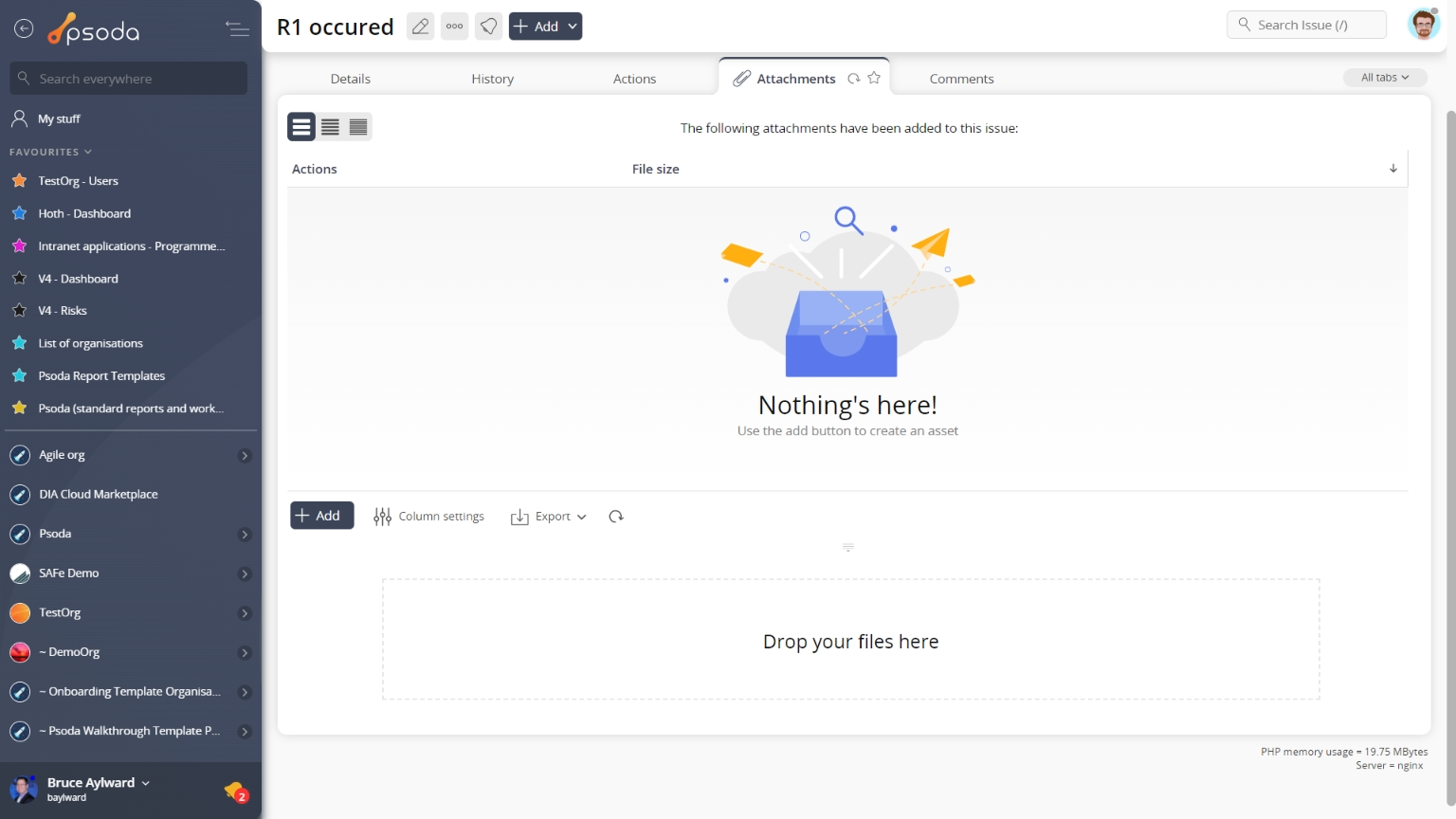
Figure 1 – Issue view page
The top header area allows you to Actions
Actions
This tab shows an asset listing of all of the actions registered for this issue, as shown in Figure 2. By default, this table will present you with a number of details about the actions such as it’s reference, description, priority and due date to name a few. If you click on the reference link of the listed action, you will navigate to that action’s view page.
From the Actions column of this actions table, you can act on individual actions by 
Figure 2 – Issue actions tab
Note that you can customise your table view by clicking the Attachments
Attachments
This tab shows an asset listing of all of the attachments that have been added to this issue, as shown in Figure 3. By default, this table will present you with a number of details about the attachments such as the file’s name, attachment type, view the version and access a download link.
From the Actions column of this attachments table, you can act on individual attachments by 
Figure 3 – Issue attachments tab
Note that you can customise your table view by clicking the Comments
Comments
This tab shows an asset listing of all of the comments that 
Figure 4 – Issue comments tab
Note that you can customise your table view by clicking the Change requests
Change requests
This tab shows an asset listing of all of the change requests that have been added to this issue, as shown in Figure 5. By default you will be presented with the change request’s reference, title, category, description, scheduling information, the user who initiated this request, the owner of the request and it’s current state. If you select the link under the reference column, you will navigate into the change request’s view page.
From the Actions column of this change requests table, you can act on individual requests by  Figure 5 – Issue change requests tab
Figure 5 – Issue change requests tab
Note that you can customise your table view by clicking the edit button at the bottom of the change requests table or navigate to this same spot to
add more change requests to this issue. Here, you can also export this list to
Excel or
CSV files.
 Details
Details
Figure 6 – Issues details tab
This tab shows the details for the selected issue which may include planning and scheduling information or any additional custom field information specific to your configurations, along with the issue’s description, implication, treatment plan and origin information, all of which have the option to accommodate for inline editing. Note that individual user editing will be dependent on access rights.
 Escalated
Escalated
This tab shows an asset listing of the asset that this issue has been escalated to, as shown in Figure 7. By default, this table will present you with a number of details about the escalated asset such as the type and name.
You can de-escalate the selected issue from the Actions column of this asset listing.

Figure 7 – Action escalated tab
Note that you can customise your table view by clicking the edit button at the bottom of the escalated table. Here, you can also export this list to
Excel or
CSV files.
 History
History
This tab shows shows some basic history of the issue, as shown in Figure 8. By default, this tab will present you with a number of details about the issue’s history such as the creation date, creation user, last update date and last update user. If the issue has been changed then this section will also show a table of all the changes that has been made, including the date of each change, the field changed, the value before the change and the user who made the change.
Figure 8 – Issue history tab
Note that you can customise your change table view by clicking the edit button at the bottom of the change table. Here, you can also export this list of changes to
Excel or
CSV files.
 Lessons
Lessons
This tab shows an asset listing of all of the lessons that have been added to this issue, as shown in Figure 9. By default you will be presented with the lesson’s context, reference, title, description, the user who created the lesson and it’s current state . If you select the link under the lesson column, you will navigate into the lesson’s view page. The workflow column also provides information as to the next workflow transitions available, if a workflow has been selected upon lesson creation.
From the Actions column of the lessons table, you can act on individual lessons by 
Figure 9 – Lessons tab
Note that you can customise your table view by clicking the